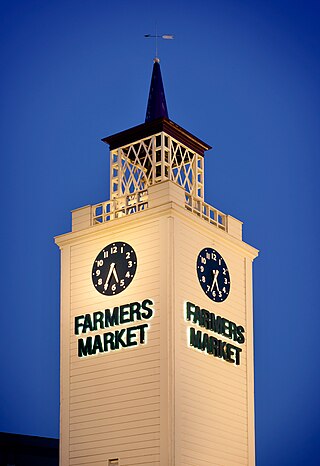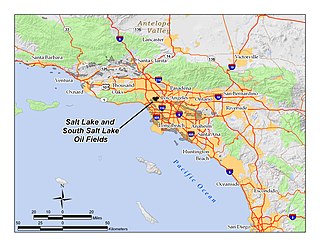Mobil is a petroleum brand owned and operated by American oil and gas corporation ExxonMobil. The brand was formerly owned and operated by an oil and gas corporation of the same name, which itself merged with Exxon to form ExxonMobil in 1999.

Amoco is a brand of fuel stations operating in the United States and owned by British conglomerate BP since 1998. The Amoco Corporation was an American chemical and oil company, founded by Standard Oil Company in 1889 around a refinery in Whiting, Indiana, and was officially the Standard Oil Company of Indiana until 1985. Originally part of the Standard Oil Company trust, it focused on producing gasoline for the new automobile market. In 1911, as part of the break-up of the Standard Oil trust, it became an independent corporation. Incorporated in Indiana, it was headquartered in Chicago, and formally adopted the name Amoco in 1985. Although the Amoco Corporation merged in 1998 into BP Amoco, the Amoco name was resurrected in 2017 as a brand that service station owners could choose to use when they purchased supplies from BP in selected areas of the United States.
ARCO is a brand of gasoline stations owned by Marathon Petroleum. BP, which formerly owned the brand, uses it in Northern California, Oregon and Washington, while Marathon has rights for the rest of the United States and Mexico.

The Standard Oil Company of Ohio was an American oil company, a successor of the original company established in 1870 by John D. Rockefeller. It was established as "Standard Oil Company of Ohio" as one of the separate entities created after the 1911 breakup.

Valero Energy Corporation is an American-based downstream petroleum company mostly involved in manufacturing and marketing transportation fuels, other petrochemical products, and power. It is headquartered in San Antonio, Texas, United States. Throughout the United States and Canada, the company owns and operates 15 refineries, and one in Wales, with a combined throughput capacity of approximately 3 million barrels (480,000 m3) per day, 11 ethanol plants with a combined production capacity of 1.2 billion US gallons (4,500,000 m3) per year, and a 50-megawatt wind farm. A Fortune 500 company, before the 2013 spinoff of CST Brands, Valero was one of the United States' largest retail operators with approximately 6,800 retail and branded wholesale outlets in the United States, Canada, United Kingdom, Mexico and Peru under the Valero, Diamond Shamrock, Shamrock, Beacon, and Texaco brands.

Fairfax Avenue is a street in the north central area of the city of Los Angeles, California, United States. It runs from La Cienega Boulevard in Culver City at its southern end to Hollywood Boulevard in Hollywood on its northern end. From La Cienega Boulevard to Sunset Boulevard, it separates the Westside from the central part of the city along with Venice Boulevard, La Cienega Boulevard, Hauser Boulevard, San Vicente Boulevard, South Cochran Avenue, Wilshire Boulevard, 6th Street, Cochran Avenue, 4th Street, La Brea Avenue, Fountain Avenue and Sunset Boulevard.

76 is a chain of gas stations located within the United States. The 76 brand is owned by Phillips 66. Unocal, the original owner and creator of the 76 brand, merged with Chevron Corporation in 2005.

Fonterra Co-operative Group Limited is a New Zealand multinational publicly traded dairy co-operative owned by New Zealand farmers. The company is responsible for approximately 30% of the world's dairy exports and with revenue exceeding NZ $22 billion, making it New Zealand's largest company. It is the sixth-largest dairy company in the world as of 2022, as well as the largest in the Southern Hemisphere.

The Fairfax District is a neighborhood in the Central region of Los Angeles, California.

Miracle Mile is a neighborhood in the city of Los Angeles, California.

The Original Farmers Market is an area of food stalls, sit-down eateries, prepared food vendors, and produce markets in Los Angeles, California, at the corner of Fairfax Avenue and 3rd Street. First opened in July 1934, it is also a historic Los Angeles landmark and tourist attraction.

United Dairy Farmers (UDF) is an American chain of shops offering dairy products as well as coffee and gasoline. UDF was started by Carl Lindner Sr. and his children in 1938. Almost as soon as they started operations, the Lindners began work on building a dairy store. Carl Sr. believed that if he could sell milk through his own store, he would not have to deal with delivery middlemen and thus pass the resulting savings on to customers. The first United Dairy Farmers store, at 3955 Main Avenue in Norwood, Ohio, a suburb of Cincinnati, opened on May 8, 1940.
Gilmore Field was a minor league baseball park in Los Angeles, California, that served as home to the Hollywood Stars of the Pacific Coast League from 1939–1957 when they, along with their intra-city rivals, the Los Angeles Angels, were displaced by the transplanted Brooklyn Dodgers of the National League.

The Grove is a retail and entertainment complex in Los Angeles, located on parts of the historic Farmers Market. The mall features Nordstrom and Barnes & Noble.
Gilmore Stadium was a multi-purpose stadium in Los Angeles, California. It was opened in May 1934 and demolished in 1952, when the land was used to build CBS Television City. The stadium held 18,000. It was located next to Gilmore Field. The stadium was located west of Curson Avenue, surrounded by Beverly Boulevard, Fairfax Avenue and Third Street. The Stadium was used in a 3 Stooges 1934 short Three Little Pigskins.
Methyl tert-butyl ether (MTBE) is a gasoline additive that replaced tetraethyllead. MTBE is an oxygenate and raises gasoline's octane number. Its use declined in the United States in response to environmental and health concerns. It has polluted groundwater due to MTBE-containing gasoline being spilled or leaked at gas stations. MTBE spreads more easily underground than other gasoline components due to its higher solubility in water. Cost estimates for removing MTBE from groundwater and contaminated soil range from $1 billion to $30 billion, including removing the compound from aquifers and municipal water supplies, and replacing leaky underground oil tanks. Who will pay for remediation is controversial. In one case, the cost to oil companies to clean up the MTBE in wells belonging to the city of Santa Monica, California is estimated to exceed $200 million.

The Salt Lake Oil Field is an oil field underneath the city of Los Angeles, California. Discovered in 1902, and developed quickly in the following years, the Salt Lake field was once the most productive in California; over 50 million barrels of oil have been extracted from it, mostly in the first part of the twentieth century, although modest drilling and extraction from the field using an urban "drilling island" resumed in 1962. As of 2009, the only operator on the field was Plains Exploration & Production (PXP). The field is also notable as being the source, by long-term seepage of crude oil to the ground surface along the 6th Street Fault, of the famous La Brea Tar Pits.

Gilmore (1930–1950) was a lion who flew with aviator Colonel Roscoe Turner to promote the Gilmore Oil Company. After he grew too large for flying, Gilmore accompanied Turner in publicity appearances for the next ten years.
Earl Bell Gilmore (1887–1964) was the son of Arthur Fremont Gilmore and took control of the family businesses, including the Gilmore Oil Company, in 1918. He was inducted into the Indianapolis Motor Speedway Museum in 1987. Gilmore was born and died in the historic Rocha Adobe. According to the Los Angeles Times, "E. B. Gilmore is credited with running one of Los Angeles' first gasoline stations...It is said that around 1910 young Gilmore would load his horsedrawn wagon with gasoline from the family refinery and then wait on the corner of Wilshire and La Brea for automobiles from the city to come by. He sold his product for 10 cents a gallon and purified it by pouring it through a chamois."














